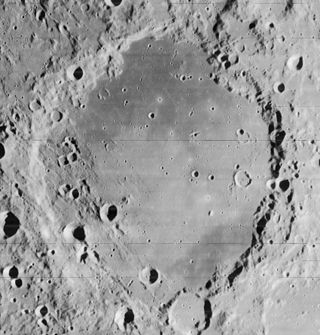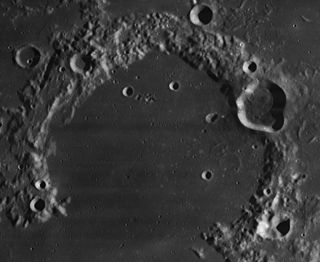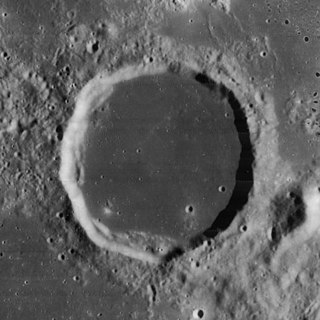
Ammonius is a bowl-shaped lunar impact crater with a slightly raised rim. It is located on the floor of the walled plain Ptolemaeus, about 30 kilometers northeast of the crater midpoint.

Beaumont is a lava-flooded crater located on the southwestern shore of the Mare Nectaris on Earth's Moon. It lies to the northwest of the similarly flooded crater remnant Fracastorius. To the west is the prominent crater Catharina. The crater is named after French geologist Léonce Élie de Beaumont.

Fracastorius is the lava-flooded remnant of an ancient lunar impact crater located at the southern edge of Mare Nectaris. To the northwest of this formation lies the crater Beaumont, while to the northeast is Rosse.

Eddington is the lava-flooded remnant of a lunar impact crater, located on the western part of Oceanus Procellarum. The western rim is attached to the wall of the walled plain Struve. To the east-southeast is the smaller but prominent crater Seleucus. South of Eddington is Krafft.

Struve is the lava-flooded remains of a lunar impact crater. It is located near the western extreme of the Oceanus Procellarum, close to the western lunar limb. As a consequence, even though it is roughly circular in outline, it appears oval due to foreshortening.

Schickard is a lunar impact crater of the form called a walled plain. It lies in the southwest sector of the Moon, near the lunar limb. As a result, the crater appears oblong due to foreshortening. Attached to the northern rim is the lesser crater Lehmann, and to the northeast is the even smaller Drebbel. Southwest of Schickard is Wargentin, a lava-flooded plateau.

Russell is the lava-flooded remains of a lunar impact crater. It is located in the western part of the Oceanus Procellarum, close to the western lunar limb. As a result, it appears oblong-shaped due to foreshortening.

Oersted is a lunar impact crater that has been flooded by lava, leaving only a crescent-shaped rim with a gap to the southwest. The rim climbs to a maximum height of 1.7 km. This feature lies to the southeast of the crater Atlas, and southwest of Chevallier. To the south-southwest is Cepheus.

Egede is the remains of a lunar impact crater that has been flooded by lava, leaving only the somewhat polygonal circumference of the rim protruding just above the mare. It was named after Dano-Norwegian natural historian Hans Egede. It is located on the southern edge of the Mare Frigoris, to the west of the crater Aristoteles. To the southwest is an arc of low mountains curving between the rims of Aristoteles and Eudoxus. The floor of Egede is flat and nearly featureless, except for a few tiny craterlets, including secondaries from Aristoteles. The surviving rim has a maximum altitude of 0.4 km above the surface.

Doppelmayer is the remains of a lunar impact crater that lies on the southwest edge of Mare Humorum. It was named after the German mathematician and astronomer Johann Gabriel Doppelmayr. To the south-southeast is another flooded crater designated Lee, and to the southeast is Vitello. Just to the east-northeast of Doppelmayer lies the nearly submerged crater Puiseux.

Thomson is a lunar impact crater that is located within the Mare Ingenii on the far side of the Moon. Just to the northeast is the unusual merged crater formation of Van de Graaff. On the northwest rim of the mare is O'Day, and to the south-southwest is Obruchev on the southern shore of Mare Ingenii.

Baily is the remnant of a lunar impact crater on the boundary between Mare Frigoris to the north and Lacus Mortis to the south. The crater interior has been flooded by lava in the past, and only the northern half of the crater rim remains relatively intact. There is an outward bulge in the northeastern rim, possibly the remnant of another crater formation that once overlapped Baily. The crater interior is flat and relatively featureless, with no impacts of significance. The surviving outer rim reaches a maximum elevation of about 0.5 km.

Billy is a lunar impact crater that is located at the southern fringes of the Oceanus Procellarum, in the western hemisphere of the Moon. It was named after French mathematician Jacques de Billy. It lies to the southeast of the similar-sized crater Hansteen, and west-southwest of the flooded Letronne.

Chamberlin is a lunar impact crater that is located on the far side of the Moon, just past the southeastern limb. It lies to the southeast of the crater Jeans, and Moulton is attached to the southeastern rim of Chamberlin. This crater is located in a part of the lunar surface that has undergone resurfacing of crater interiors, producing dark-hued crater floors.

Baldet is a lunar impact crater that is located on the southern hemisphere on the far side of the Moon. It lies in the lava-flooded region between the craters Cori to the north, Stoney to the southwest, and the worn walled plain Minkowski to the southeast.

Loewy is a small lunar impact crater that lies along the eastern rim of Mare Humorum, in the southwest part of the Moon's near side. It was named after French astronomer Maurice Loewy. This is a lava-flooded formation that lies to the southwest of the larger, lava-flooded crater Agatharchides. To the southeast is an even larger lava-flooded formation, Hippalus.

Cook is a lunar impact crater that lies in the western part of the Mare Fecunditatis, just to the southeast of the prominent crater Colombo. To the southwest is Monge.

Daubrée is a lunar impact crater that is located to the southwest of the Mare Serenitatis, just to the west-southwest of the crater Menelaus in the Montes Haemus range. The small lunar mare Lacus Hiemalis lies along the southwest rim of Daubrée. The crater was named after French geologist Gabriel A. Daubrée. It was previously designated Menelaus S.

Chevallier is a lunar impact crater that is located in the northeastern part of the Moon's near side, about a crater diameter east-southeast of the prominent crater Atlas. To the south-southeast of Chevallier is the flooded crater Shuckburgh. Chevallier was named by the IAU in 1935.

Cichus is a lunar impact crater that lies in the southwestern part of the Moon, at the eastern edge of Palus Epidemiarum. Just to the northeast and nearly contacting the rim is the lava-flooded crater remnant Weiss. The crater is named after Italian astronomer Cecco d'Ascoli.





















